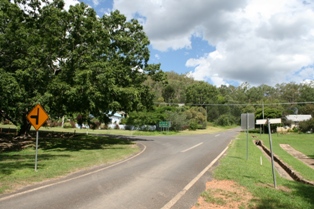
John Moffat was a Scottish-born entrepreneur who developed a mining and industrial empire around Loudoun Mill and Irvinebank in North Queensland which drove the development of north-eastern Australia. He was a devout Swedenborgian who was famous for both vision and enterprise. He was born in Newmilns, Ayrshire and spent most of his youth immersed in books. Extremely shy in temperament, he was known to hide whenever visitors approached. It was a habit he was to retain throughout his life.

Irvinebank Dam (also known as Loudoun Weir) is a heritage-listed timber and concrete weir initially constructed around 1885 when a tin battery was built. The two creeks which form the basis of the dam at Irvinebank were known as Gibbs Creek and McDonald Creek, after the earliest prospectors. The battery was erected on the Gibbs Creek frontage, and the dam was constructed just below the junction of these two creeks and embraced an area, when full, of about 12 - 13 acres (53,000 m2) of water, with depths varying from about 15 feet (4.6 m) down to about two or three feet. The original capacity was 150 million litres (33,000,000 imp gal; 40,000,000 US gal).

Irvinebank is a rural town and locality in the Shire of Mareeba, Queensland, Australia. In the 2021 census, the locality of Irvinebank had a population of 113 people.

Wairuna is a heritage-listed detached house at 27 Hampstead Road, Highgate Hill, City of Brisbane, Queensland, Australia. It was designed by Robin Dods and built from 1896 to 1900. It was added to the Queensland Heritage Register on 21 October 1992.

Barron Valley Hotel is a heritage-listed hotel at 53 Main Street, Atherton, Tablelands Region, Queensland, Australia. It was designed by Hill & Taylor and built from 1940 to 1941. It was added to the Queensland Heritage Register on 5 February 2010.

Holy Trinity Anglican Church is a heritage-listed church at 38 Broadway Street, Herberton, Tablelands Region, Queensland, Australia. It was designed by Eyre & Munro and built in 1889 by H Petersen. It is also known as Holy Trinity Church of England. It was added to the Queensland Heritage Register on 21 October 1992.

Herberton School of Arts is a heritage-listed school of arts at 61 Grace Street, Herberton, Tablelands Region, Queensland, Australia. It was built in 1881. It was added to the Queensland Heritage Register on 21 October 1992.

Herberton Uniting Church was a heritage-listed Uniting church at 2–4 Lillian Street, Herberton, Tablelands Region, Queensland, Australia. It was built in 1891 by R Petersens. It was also known as Herberton Presbyterian Church. It was added to the Queensland Heritage Register on 27 August 1999.

Great Northern Mine is a heritage-listed mine off Jacks Road, Herberton, Tablelands Region, Queensland, Australia. It was built from 1880 to 1940s. It was added to the Queensland Heritage Register on 21 October 1992.

Coolgarra Battery is a heritage-listed stamper battery at Coolgarra Station, Silver Valley, Tablelands Region, Queensland, Australia. It was built from 1896 to 1901. It is also known as Coolgarra Old Furnace. It was added to the Queensland Heritage Register on 25 August 2000.

St Patrick's Church is a heritage-listed Roman Catholic church at 1 Penda Street, Yungaburra, Tablelands Region, Queensland, Australia. It was built from 1914 to 1930s. It is also known as Our Lady of Ransom. The church is part of the Roman Catholic Diocese of Cairns. It was added to the Queensland Heritage Register on 21 October 1992.

Queensland National Bank is a heritage-listed former bank building at Jessie Street, Irvinebank, Shire of Mareeba, Queensland, Australia. It was built c. 1905. It was added to the Queensland Heritage Register on 21 October 1992.

Loudoun House is a heritage-listed detached house at 16 O'Callaghan Street, Irvinebank, in the Shire of Mareeba in Queensland, Australia. It was built c. 1883–1884. It is also known as Moffat's House. It was added to the Queensland Heritage Register on 21 October 1992. It is now operated as the Loudoun House Museum by the Irvinebank School of Arts & Progress Association.

Irvinebank State Treatment Works is a heritage-listed refinery off Jessie Street, Irvinebank, Shire of Mareeba, Queensland, Australia. It was built from 1883 to c. 1908. It is also known as Loudoun Mill. It was added to the Queensland Heritage Register on 21 October 1992.

Vulcan Mine is a heritage-listed former mine at Mareeba Mining District, Irvinebank, Shire of Mareeba, Queensland, Australia. It was built from c. 1889 to 1930s. It was added to the Queensland Heritage Register on 21 October 1992.

Stannary Hills Tramways are a heritage-listed pair of tramways at Irvinebank, Shire of Mareeba, Queensland, Australia. It was built from 1901 to 1907. It was added to the Queensland Heritage Register on 25 February 2005.

Einasleigh Hotel is a heritage-listed hotel at Daintree Street, Einasleigh, Shire of Etheridge, Queensland, Australia. It was built from 1908 to 1909. It is also known as Central Hotel. It was added to the Queensland Heritage Register on 6 February 2006.

The Etheridge railway line is a heritage-listed railway line between Mount Surprise and Forsayth, both in the Shire of Etheridge, Queensland, Australia. It includes Mount Surprise railway station, Einasleigh railway station, Wirra Wirra railway station and Forsayth railway station. Etheridge railway line was added to the Queensland Heritage Register on 16 February 2009.

Croydon Shire Hall is a heritage-listed town hall at Samwell Street, Croydon, Shire of Croydon, Queensland, Australia. It was built c. 1892. It is also known as Croydon Shire Office and Croydon Town Hall. It was added to the Queensland Heritage Register on 11 June 1996.

Irvinebank State School is a heritage-listed state school at High Street, Irvinebank, Shire of Mareeba, Queensland, Australia. It was designed by Robert and John Ferguson, Queensland Department of Public Works and built from 1889 to 1906 by Thomas Gordon and August Conrad Ferdinand Ohnesorgen. It was added to the Queensland Heritage Register on 1 May 2015.






















